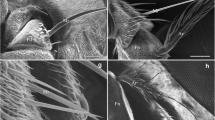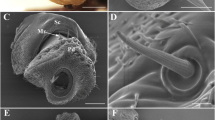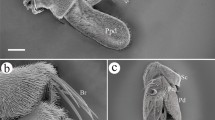Abstract
The latrine fly (Fannia scalaris) and lesser house fly (Fannia canicularis) are ubiquitous fanniid species of forensic and medical importance. The external morphology of sensilla on the antennae is studied using a stereoscopic microscope and scanning electron microscope, and the internal structure of the antennae is revealed by paraffin sections under the light microscope and laser scanning confocal microscope. Only grooved bristles are found on the scape and pedicel. Four major types of surface sensilla are found on the antennal funiculus and are classified as: (a) trichoid sensilla, (b) two subtypes of basiconic sensilla, (c) clavate sensilla, and (d) coeloconic sensilla. Density of each sensilla type of the two species is calculated. A remarkable difference is observed that the higher density of clavate sensilla occurs on the posteroventral surface in F. scalaris, whereas they are on the anterodorsal surface in F. canicularis. Several cuticular depressions that were previously known as “olfactory pits” are observed on the funiculus of both species. Combining with previous studies, they are suggested to be classified into two types: pit and sacculus. Pit is single-chambered and filled with one type of sensilla, whereas the sacculus is a multi-chambered pit organ containing several types of sensilla. Surprisingly, the pits observed in our study are mostly situated at the lateral region of the antennal funiculus, whereas in other flies, they are found on the posteroventral or anterodorsal surface of antennal funiculus. In addition, the sacculus found in our study houses only basiconic-like sensilla, which is remarkably different from other findings. Moreover, observation under light microscope indicates that previous data of the complexity and the number of the “olfactory pits,” which are an important type of efficient sensory convergence, could be underestimated. Thus, more precise methods such as paraffin section or transmission electron microscope are suggested for further study.







Similar content being viewed by others
References
Adams TS, Holt GG (1987) Effect of pheromone components when applied to different models on male sexual behavior in the housefly, Musca domestica. J Insect Physiol 33:9–18
Amer A, Mehlhorn H (2006) The sensilla of Aedes and Anopheles mosquitoes and their importance in repellency. Parasitol Res 99:491–499
Aspock H (1972) Rectal myiasis due to Fannia canicularis (Linnaeus) and Muscina stabulans (Fallén). Deut Med Wochenschr 97:1174–1175
Aspock H, Burkert S, Reichmann A (1972) Urethral myiasis caused by Fannia canicularis. Wien Klin Wochenschr 84:280–281
Benecke M, Lessig R (2001) Child neglect and forensic entomology. Forensic Sci Int 120:155–159
Bin F, Colazza S, Isidoro N, Solinas M, Vinson SB (1989) Antennal chemosensilla and glands, and their possible meaning in the reproductive behaviour of Trissolcus basalis (Woll) (Hymenoptera: Scelionidae). Entomologica 30:33–97
Bogner F, Boppré M, Ernst KD, Boeckh J (1986) CO2 sensitive receptors on labial palps of Rhodogastrica moths (Lepidoptera: Arctiidae): physiology, fine structure and central projection. J Comp Physiol 158:741–749
Brightwell R, Dransfield R (1997) Odour attractants for tsetse: Glossina austeni, G. brevipalpis and G. swynnertoni. Med Vet Entomol 11:297–299
Bunchu N, Sukontason KL, Olson JK, Kurahashi H, Sukontason K (2008) Behavioral responses of Chrysomya megacephala to natural products. Parasitol Res 102(3):419–429
Carlson DA, Langley PA, Huyton P (1978) Sex pheromone of the tsetse fly: isolation, identification and synthesis of contact aphrodisiacs. Science 201:705–753
Chillcott JG (1961) A revision of the Nearctic species of Fanniinae (Diptera: Muscidae). Can Entomol Suppl 14:1–295
Domínguez MC, Roig-Juñent SA (2011) Historical biogeographic analysis of the family Fanniidae (Diptera: Calyptratae), with special reference to the austral species of the genus Fannia (Diptera: Fanniidae) using dispersal-vicariance analysis. Rev Chil Hist Nat 84:65–82
Ernst KD, Boeckh J, Boeckh V (1977) A neuroanatomical study of the the central antennal pathways in insects. II. Deutocerebral connections in Locusta migratoria and Periplaneta americana. Cell Tissue Res 176:285–308
Forster M, Klimpel S, Mehlhorn H, Sievert K, Messler S, Pfeffer K (2007) Pilot study on synanthropic flies (e.g. Musca, Sarcophaga, Calliphora, Fannia, Lucilia, Stomoxys) as vectors of pathogenic microorganisms. Parasitol Res 101(1):243–246
Guha L, Seenivasagan T, Bandyopadhyay P, Iqbal ST, Sathe M, Sharma P, Parashar BD, Kaushik MP (2012) Oviposition and flight orientation response of Aedes aegypti to certain aromatic aryl hydrazono esters. Parasitol Res 111(3):975–982
Hammack L (1991) Sex pheromone communication in the screwworm, Cochliomyia hominivorax: ontogenetic and strain effects. J Chem Ecol 17:2143–2154
Hunter FF, Adserballe CF (1996) Cuticular structures on the antennae of Hypoderma bovis De Geer (Diptera: Oestridae) females. Int J Insect Morphol Embryol 25:173–181
Isidoro N, Bin F, Colazza S, Vinson SB (1996) Morphology of antennal gustatory sensilla and glands in some parasitoid hymenoptera with hypothesis on their role in sex and host recognition. J Hymenopt Res 5:206–239
Kelling-Johannes F (2001) Olfaction in houseflies: morphology and electrophysiology. PhD Dissertation. University of Groningen, Groningen
Lee JK, Selzer R, Altner H (1985) Lamellated outer dendritic segments of a chemoreceptor within wall-pore sensilla in the labial palp pit organ in the butterfly, Pieris rapae L. (Insecta: Lepidoptera). Cell Tissue Res 240:333–342
Ma ZY (1992) Fannia Robineau-Desvoidy. In: Fan ZD (ed) The common flies of China. Science Press, China, pp 214–219
Perez-Eid C, Mouffok N (1999) Human urinary myiasis caused by Fannia canicularis (Diptera, Muscidae) larvae in Algeria. Presse Med 28:580–581
Reibe S, Strehler M, Mayer F, Althaus L, Madea B, Benecke M (2008) Dumping of corpses in compost bins—two forensic entomological case report. Arch Kriminol 222:195–201
Ren HW, Bai FJ, Lu YY, Wang MF (2011) Observation on antennal sensilla of Fannia scalaris with scanning electron microscope. Chinese J Appl Entomol 48(4):1038–1041 [in Chinese]
Ross KTA (1992) Comparative study of the antennal sensilla of five species of root maggots: Delia radicum L., D. floralis F., D. antique Mg., D. platura Mg. (Diptera: Anthomyiidae), and Psila rosae F. (Diptera: Psilidae). Int J Insect Morphol Embryol 21:175–197
Ross KTA, Anderson M (1987) Morphology of the antennal sensilla of the cabbage root fly, Delia radicum L. (Diptera: Anthomyiidae). Int J Insect Morphol Embryol 16:331–342
Setzu MD, Poddighe S, Angioy AM (2011) Sensilla on the antennal funiculus of the blow fly, Protophormia terraenovae (Diptera: Calliphoridae). Micron 42:471–477
Shanbhag SR, Müller B, Steinbrecht RA (1999) Atlas of olfactory organs of Drosophila melanogaster: types, external organization, innervation and distribution of olfactory sensilla. Int J Insect Morphol Embryol 28:377–397
Shanbhag SR, Singh K, Singh RN (1995) Fine structure and primary sensory projections of sensilla located in the sacculus of the antenna of Drosophila melanogaster. Cell Tissue Res 282:237–249
Silhacek DL, Carlson DA, Meyer MS, James DJ (1972) Composition and sex attractancy of cuticular hydrocarbons from houseflies: effects of age, sex and mating. J Insect Physiol 18:347–354
Smallegange RC, Kelling RJ, Den Otter CJ (2008) Types and numbers of sensilla on antennae and maxillary palps of small and large houseflies, Musca domestica (Diptera, Muscidae). Microsc Res Tech 71:880–886
Sukontason K, Methanitikorn R, Chaiwong T, Kurahashi H, Vogtsberger RC, Sukontason KL (2007a) Sensilla of the antenna and palp of Hydrotaea chalcogaster (Diptera: Muscidae). Micron 38:218–223
Sukontason K, Narongchai P, Kanchai C, Vichairat K, Sribanditmongkol P, Bhoopat T, Kurahashi H, Chockjamsai M, Piangjai S, Bunchu N, Vongvivach S, Samai W, Chaiwong T, Methanitikorn R, Ngern-Klun R, Sripakdee D, Boonsriwong W, Siriwattanarungsee S, Srimuangwong C, Hanterdsith B, Chaiwan K, Srisuwan C, Upakut S, Moopayak K, Vogtsberger RC, Olson JK, Sukontason KL (2007b) Forensic entomology cases in Thailand: a review of cases from 2000 to 2006. Parasitol Res 101(5):1417–1423
Tuzun A, Dabiri F, Yuksel S (2010) Preliminary study and Identification of insects' species of forensic importance in Urmia, Iran. Afr J Biotechnol 9(4):3649–3658
Velasquez Y (2008) A checklist of arthropods associated with rat carrion in a montane locality of northern Venezuela. Forensic Sci Int 174:67–69
Wasserman SL, Itagaki H (2003) The olfactory responses of the antenna and maxillary palp of the fleshfly, Neobellieria bullata (Diptera: Sarcophagidae), and their sensitivity to blockage of nitric oxide synthase. J Insect Physiol 49:271–280
Werner H, Rall E, Hendrischk A (1975) Urogenital myiasis with Fannia scalaris. Deut Med Wochenschr 100:1397–1398
Weseloh RM (1972) Sense organs of the hyperparasite Cheiloneurus noxius (Hymenoptera: Encyrtidae) important in host selection processes. Ann Entomol Soc Am 65:41–46
Yan BK, Sai SY (1996) Flies and diseases. Chinese Journal of Pest Control 12:41–48
Ye ZM (2003) The classification and identification of common flies of China. In: Lu BL, Wu HY (eds) Classification and identification of important medical insects of China. Henan Science and Technology Press, Henan, pp 388–389
Zhang D, Wang QK, Hu DF, Li K (2012a) Cuticular structures on antennae of the bot fly, Portschinskia magnifica (Diptera: Oestridae). Parasitol Res 111(4):1651–1659
Zhang D, Wang QK, Hu DF, Li K (2012b) Sensilla on the antennal funiculus of the horse stomach bot fly, Gasterophilus nigricornis. Med Vet Entomol 26(3):314–322
Acknowledgments
We are grateful to Dr. Meiqin Liu and Mrs. Hui Zhang (Beijing Forestry University, Beijing, China) for their invaluable help with this study. We also thank Ms. April Gloury (University of Melbourne, Melbourne, Australia) for her assistance in proofreading of the manuscript. This study was supported by the Program for New Century Excellent Talents in University (no. NCET-12-0783), the National Nature Science Foundation of China (no. 31201741), and the Chinese Postdoctoral Science Foundation (no. CPSF-20100470009, no. SFG-201104059).
Author information
Authors and Affiliations
Corresponding author
Rights and permissions
About this article
Cite this article
Zhang, D., Wang, Q.K., Yang, Y.Z. et al. Sensory organs of the antenna of two Fannia species (Diptera: Fanniidae). Parasitol Res 112, 2177–2185 (2013). https://doi.org/10.1007/s00436-013-3377-4
Received:
Accepted:
Published:
Issue Date:
DOI: https://doi.org/10.1007/s00436-013-3377-4




